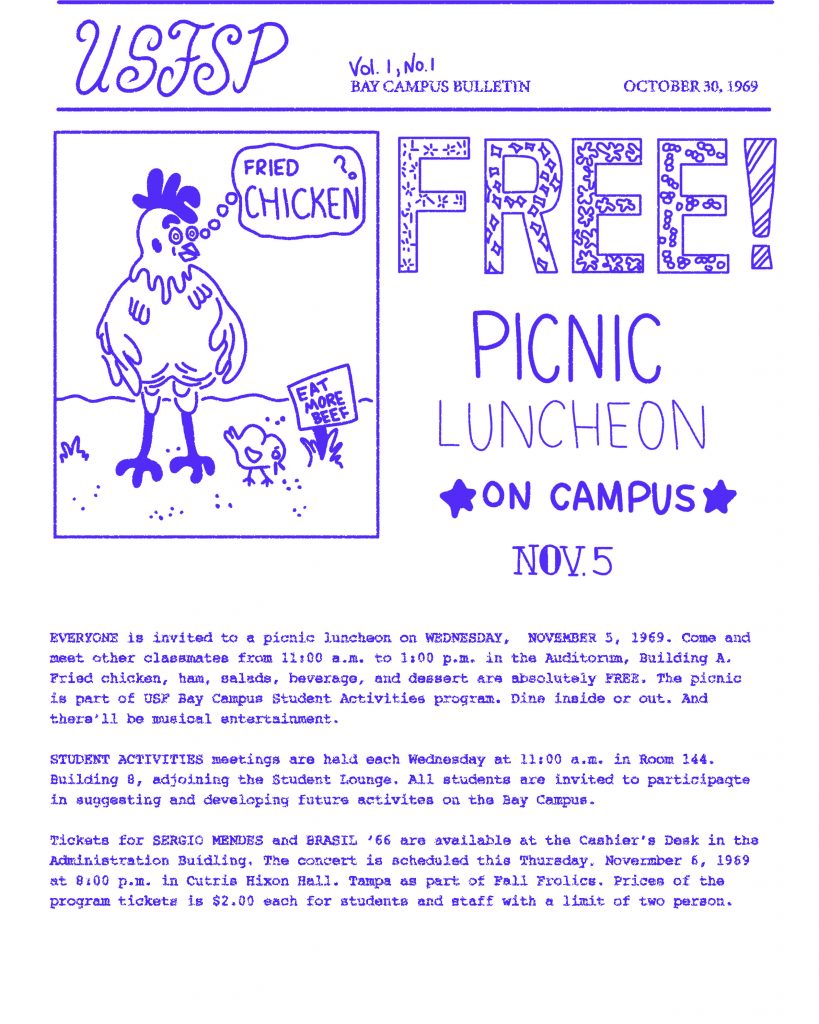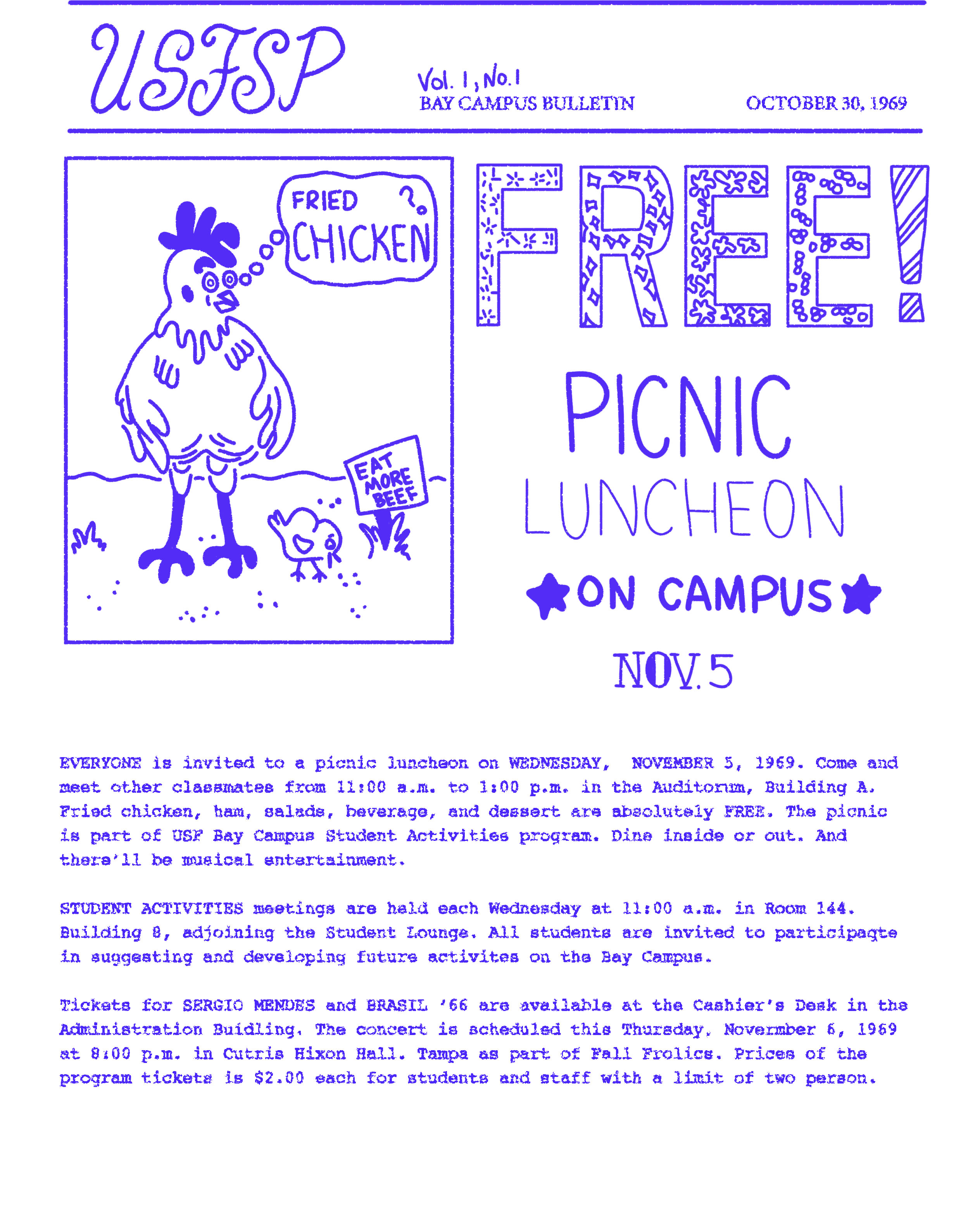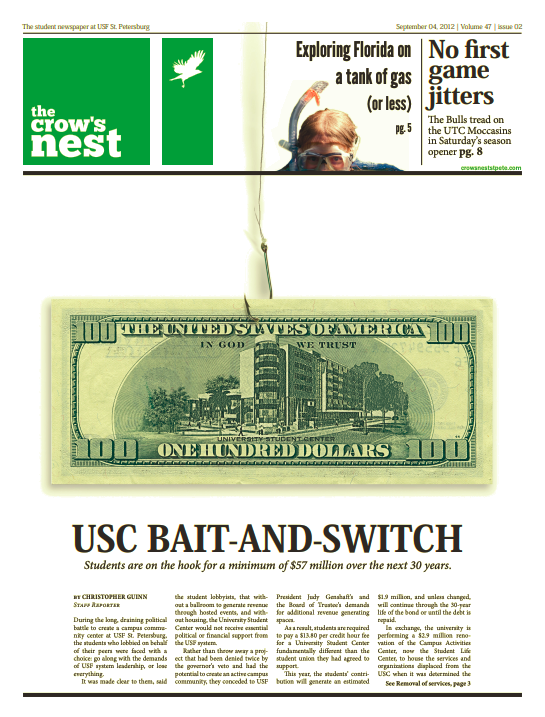
Courtesy of David Shedden, Nelson Poynter Memorial Library, and remastered by MK Brittain
By Crow’s Nest Staff
It all started with a chicken.
The campus activities program at the tiny Bay Campus of USF was sponsoring a fried chicken picnic and wanted to get the word out.
So a junior named Joan “Sudsy” Tschiderer did a crude drawing of a chicken, typed up a page of campus news briefs and ran off several dozen copies on an old Ditto duplicating machine.
She called her flyer the “Bay Campus Bulletin,” not knowing that she had created Volume 1, Number 1 of a campus newspaper that evolved into today’s Crow’s Nest.
“I was used to being an editor (at St. Petersburg Junior College), so it was quite natural for me to volunteer for this,” said Tschiderer. “It was quite a humbling scenario to come from professional publications to a modest bulletin, but the goal was to communicate and grow our campus by interconnecting with each other.”
This week marks the 50th anniversary of that humble beginning on Oct. 30, 1969.
It comes at a time when the newspaper, like the campus itself, faces an uncertain future.
The campus will lose its separate accreditation – and, some fear, its distinct identity – when the three campuses of the USF system are consolidated on July 1.
There is also talk of merging The Crow’s Nest with its counterpart on the Tampa campus, perhaps in an online-only format, once consolidation takes root in a few years.
That adds another layer of uncertainty beneath a student newspaper that is already beset by the crosscurrents of Student Government politics and rapid changes in the news industry itself.
SG sets The Crow’s Nest budget each year when it allocates the revenue from student fees to campus organizations. That means the budget fluctuates, often dramatically, from year to year.
It is not clear what will happen when the student governments on three campuses are consolidated.
There has sometimes been talk of having The Crow’s Nest financed by the USF administration, but that would put the newspaper under the same university officials who are sometimes rankled by the paper’s coverage.
A new name
When the first issue of the paper rolled out of the Ditto machine in 1969, the St. Petersburg campus was only 4 years old.
It had opened in 1965 only because the University of South Florida in Tampa admitted more freshmen than it could house. Nearly 260 freshmen were sent to St. Petersburg to begin their college careers on an 11.8-acre finger of land along Bayboro Harbor.
They attended class in buildings that had housed the U.S. Maritime Service Training Station between 1939 and 1950 and the provisional campus of Florida Presbyterian College (now Eckerd College) from 1959 to 1963.
That finger of land is today the site of the College of Marine Science and the state Fish and Wildlife Conservation Commission.
For the next few years, USF experimented with the Bayboro facilities until settling on a plan to offer courses for upperclassmen and graduate students that would complement the program at St. Petersburg Junior College.
The Legislature made it official in 1969, dubbing the campus the University of South Florida – St. Petersburg and making it the first branch campus in the state university system.
There were 550 students – many of them part time – taking classes in the fall of 1968, according to the St. Petersburg Times. By the next fall, that number had nearly doubled.
One of them was Tschiderer, who earned a bachelor’s in English in 1971 (and later a master’s in English) and began a career in the university’s student affairs and university relations departments that made her the longest serving full-time staff person in the campus’ history.
The little campus bulletin she started got a new name on Oct. 20, 1970 – The Crow’s Nest.
On sailing ships of old, the crow’s nest was a platform high on the mast that was used as a lookout. The name, which seemed perfect on a campus alongside Bayboro Harbor, came out of a contest won by English professor Bill Garrett.
That first issue of the newly named paper proudly declared that it would be “your lookout on our waterfront campus.”
Despite its fancy new name, the paper remained a small publication with modest ambitions for many years.
There was no journalism department on campus to nurture students looking for a chance to sharpen their skills. So the paper relied on enthusiastic students like Tschiderer to churn out short stories on campus events and people.
After she graduated in 1971, Tschiderer joined the campus activities office but remained mother hen of The Crow’s Nest, recruiting and rallying staff, typing the stories, and then getting the paper reproduced and distributed.
The old Ditto machine, which used “purple ink that got all over me,” gave way to a more “advanced” mimeograph machine, then a Xerox machine and finally a Risograph duplicating machine that “allowed us to use various colors of ink,” said Tschiderer.
For a time, the paper featured a gossip columnist with the pseudonym of Loretta Lovely who liked to mix high school-ish questions with tart observations. (A sample: “To P.A., Loretta wants to tell you that she is very glad your skirts are shorter but they are still NOT SHORT ENOUGH.)
What may have been the first editorial came on Dec. 1, 1971, when editor Jan Taylor complained that the Tampa campus was dictating what day class registration should be in St. Petersburg.
“Tampa, wake up!” she wrote. “Our fees are the same, the credits we take equal yours. Stop treating this campus like an unwanted step-child.”
An awkward pause
For years, however, the campus remained very much the stepchild of Tampa.
In the mid-1970s, university leaders toyed with the idea of moving the campus to Clearwater. But in February 1975 voters in Clearwater rejected a proposal calling for the city to donate 100 acres for a new campus.
That seemed to light a fire under St. Petersburg city officials, who in 1976-1977 acquired and cleared land along the north shore of Bayboro Harbor to expand the campus.
The first phase of the expansion led to dedication of two new buildings in 1981 – the Nelson Poynter Memorial Library (now Bayboro Hall) and Bayboro Hall (now Davis Hall) – followed by Coquina Hall (now Heller Hall) in 1984.
As the campus expanded, so did its curriculum.
In 1988, G. Michael Killenberg was hired to begin a master’s program in print journalism and teach mass communications courses to undergraduates.
As founding director of the journalism department (now called the Department of Journalism and Digital Communication), he built a faculty and mentored many Crow’s Nest editors over the years.
But first, there was an awkward pause at the paper, which did not publish between the summer of 1989 and the fall of 1991.
It was a time of transition in the campus activities department, Tschiderer said, and there was a shortage of funds, staff and student volunteers to get the paper out.
As journalism graduate students began arriving, however, The Crow’s Nest resumed publication in October 1991 and began an upward trajectory.
Meg Gilbert had been a journalist for a decade when she came to St. Petersburg to get a master’s to enhance her career. In the fall of 1992, she became the paper’s first paid adviser at an annual salary of $5,200. Student Government authorized the funds.
For the next two semesters, Gilbert oversaw production of the little paper while beginning the planning to turn it into a tabloid printed on newsprint paper.
In the summer of 1993, she passed the baton to another graduate student, John Gogick, who had come to the university from a newspaper sports editing job in Oklahoma.
It was Gogick who completed negotiations with a printer, bought the necessary equipment and helped assemble the student staff that produced the first tabloid edition on Aug. 25, 1993.
The paper, which appeared every other week, was an eight-page casserole of sometimes stale news, commentary, club items and calendars. But it was a start.
A separate university
As the campus expanded northward, more than its footprint was changing.
The Campus Activities Center (now called the Student Life Center) opened in 1990, a new building for the Poynter Library in 1996, the first dormitory (Residence Hall Once) in 2006, the University Student Center (and second dormitory) in 2012, and a new building for the College of Business in 2017.
The college carries the name of Kate Tiedemann, the philanthropist who in 2014 gave the university $10 million – the largest gift in campus history.
In the fall of 1998, the St. Petersburg campus had welcomed its first freshman class since the overflow class of 1965. By then, many professors and administrators were chafing at what they called the heavy-handed rule of the Tampa administration.
In 2000, a proposal to sever St. Petersburg from Tampa and make it a separate university fell a few votes short in the state Legislature.
But it helped spark changes for the St. Petersburg campus – an expansion of course offerings and degree programs, increased autonomy, and planning for separate accreditation.
In July 2006, after 41 years under Tampa control, the St. Petersburg campus was awarded independent accreditation – a crucial change in academic governance that help prompt a spurt in growth and prestige at the little waterfront university.
The Legislature’s unexpected decision in 2018 to abolish that separate accreditation plunged the campus into confusion and controversy that still linger as the three campuses of the USF system prepare to consolidate next July.
‘The few, the proud’
Since the first tabloid edition of The Crow’s Nest appeared in 1993, the paper’s look and style have evolved over the years.
But some things have never changed: The funding from Student Government has varied from year to year, and so have the skills of the staff and the quality of the paper.
In some years, the editors have had little or no professional experience – and it showed. This year’s staff has five editors who have had professional internships.
On production day – which nowadays is Sunday – a handful of editors converge on the newspaper’s small office in the Student Life Center to edit the copy and lay out the pages.
“It’s the same every year,” said Rob Hooker, a former Tampa Bay Times reporter and editor who has been Crow’s Nest adviser since 2013. “It’s like the Marines – you know, ‘the few, the proud.’ Eight or nine students do 80 percent of the work. That never seems to change.”
Many editors work on the paper for only a year or two. That leads to rookie mistakes and means the paper’s coverage sometimes reflects a lack of institutional memory, Hooker said.
The Crow’s Nest has not shied away from sensitive issues, however.
Its coverage of the funding of the new University Student Center in 2012 raised the hackles of the university administration in Tampa.
In 2016, the paper disclosed why the campus’ top academic administrator had been abruptly dismissed in February 2015 in a move shrouded in secrecy.
Records obtained – and published – by the paper showed that he had propositioned a female professor and made sexually offensive remarks at an off-campus event.
The Crow’s Nest also reported why the vice president-elect of Student Government suddenly resigned in the spring of 2017: He had been named in an allegation of sexual assault filed by a female student.
In recent years, the paper chronicled the uneasy relationship between St. Petersburg and Judy Genshaft, who changed the leadership of the campus six times during her 19 years as USF system president.
The last leader Genshaft replaced was Sophia Wisniewska, who was ousted in September 2017 for botching preparations for Hurricane Irma. The abrupt departure stunned the campus, and in interviews with The Crow’s Nest some veteran professors criticized the way Genshaft handled it.
Genshaft’s last conflict with St. Petersburg was epic.
Throughout the months of planning for consolidation, she declined to support making St. Petersburg and Sarasota-Manatee full branch campuses with hiring and budgetary responsibility, as recommended by a task force mandated by the Legislature. (The consolidation plan offered earlier this month by her successor, Steve Currall, would make the branch campus designation official.)
The Crow’s Nest coverage of consolidation – and Genshaft’s maneuvering – won plaudits in St. Petersburg and a shout-out from the editorial board of the Tampa Bay Times.
The Society of Professional Journalists also applauded the paper’s coverage.
It named Nancy McCann, a graduate student who covers consolidation, the second best college news reporter in the Southeast last June in its annual Green Eyeshade Award competition.
This report was compiled from Crow’s Nest files and material provided by James Anthony Schnur, the former special collections librarian at the Nelson Poynter Memorial Library; David Shedden, the current special collections librarian; and Joan “Sudsy” Tschiderer, the newspaper’s founder. It also has material from the Tampa Bay Times and websites of USF St. Petersburg.
To view more editions in The Crow’s Nest archive, visit https://digital.usfsp.edu/crows_nest/.



